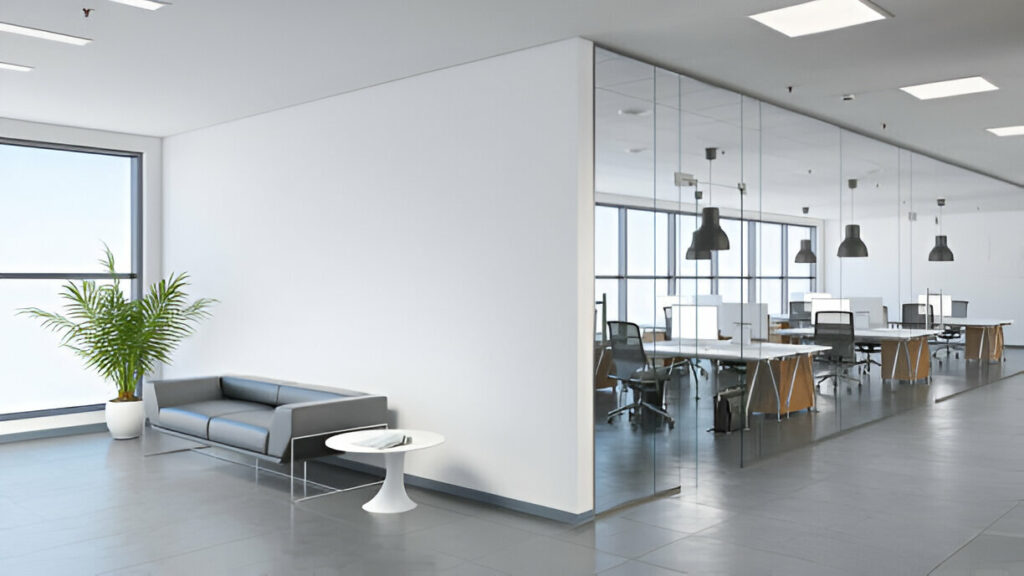Office partitioning is more than just a physical barrier. It’s critical to creating a functional, aesthetically pleasing, and productive work environment. It defines spaces for privacy and collaboration and contributes to the overall office ambience and flow.
The options can seem overwhelming, with many partition types available, ranging from traditional plaster partition walls to modern glass and acoustic panels. This article delves into the various types of office dividers, exploring their characteristics, benefits, and considerations to help businesses make informed decisions when designing or renovating their workspace.
Plaster Wall Partitions:
Plaster walls or solid dividers are a classic choice for dividing office space. Constructed from materials such as drywall or plasterboard, these partitions offer privacy, sound insulation, and structural stability. They provide a sense of permanence and solidity, making them suitable for areas requiring enhanced privacy and noise control, such as individual offices and conference rooms. Additionally, plaster wall dividers can be customised with paint, wallpaper, or textured finishes to complement the office decor and branding.
Glass Dividers:
Glass divisions have become popular in modern office design because they can create open, airy environments while maintaining visual connectivity. Made from tempered or laminated glass, these partitions let natural light infiltrate deep into the workspace, creating a bright and inviting atmosphere. Glass dividers come in various configurations, including full-height, half-height, and frameless designs, offering flexibility in space planning and aesthetics. They promote transparency, collaboration, and a sense of spaciousness, making them ideal for open-plan offices, meeting rooms, and collaborative work areas.
Acoustic Panels:
Acoustic panels provide an effective sound control and privacy solution in open-office environments where noise levels can be a concern. These panels are generally made from sound-absorbing elements such as fabric-wrapped fibreglass or acoustic foam. By reducing reverberation and dampening noise, acoustic panels create quieter, more comfortable workspaces conducive to concentration and productivity. They can be installed as wall-mounted panels, ceiling baffles, or freestanding screens, offering versatility in addressing specific acoustic challenges and design preferences.
Modular Partitions:
Modular partitions offer flexibility and adaptability in office layout and space utilisation. These divisions consist of prefabricated panels or modules that can be easily constructed, reconfigured, or relocated. Modular separators come in various materials and finishes, including fabric, laminate, and metal, allowing customisation to match the office aesthetic. They are ideal for agile work environments where spatial requirements frequently change, providing an efficient and cost-effective solution for accommodating evolving business needs.
Demountable Partitions:
Demountable partitions offer the benefits of flexibility and sustainability by allowing for easy installation, disassembly, and reuse. These separations are designed to be installed without needing permanent alterations to the building structure, making them suitable for leased spaces or buildings with changing occupancy requirements. Demountable partitions come in various styles and materials, including steel frames with interchangeable panels, providing versatility in design and functionality. They allow businesses to adapt their workspace quickly and efficiently without the expense and disruption of traditional construction methods.
Biophilic Divisions:
Biophilic dividers integrate elements of nature into the office environment, promoting employee well-being, productivity, and connection to nature. These partitions incorporate living plants, green walls, or natural elements like timber and stone to create a sense of biophilia – the innate human tendency to seek connections with nature. Biophilic dividers enhance aesthetics and improve air quality, reduce stress, and increase cognitive function, contributing to a healthier and more harmonious work environment. They can be employed as standalone components or integrated into existing partition systems, adding a touch of greenery and tranquillity to the workspace.
In conclusion, office dividers offer many possibilities for creating functional, aesthetically pleasing, and productive workspaces. From traditional plaster partition walls to modern glass partitions and acoustic panels, the choice of partition type can significantly influence the design and atmosphere of the office. Whether seeking privacy, transparency, acoustic control, or biophilic elements, there is a partitioning solution to suit every need and enhance the quality of the work environment.



